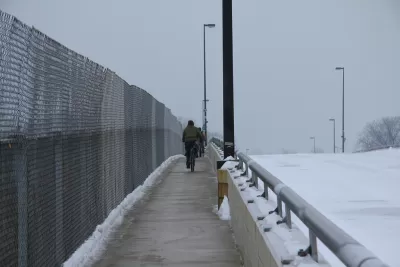"It's too cold to walk here" is often the response to the subject of livability in northern climes. Hazel Borys hails from the third coldest city of its size on earth and talks walkable winter cities.

"Walkability mitigates the most extreme climates by providing interesting places to warm up, linger, and connect. And plenty of options about how and where to turn around and circle back."
Northern cities tend to go after big silver bullets for making their cities appealing in the winter, to compete with the Sun Belt. These bullets are generally set in the city center, and are regional draws to get people to drive somewhere and then spend time outside. However, the greatest parts of walkable winter cities aren’t about the headliners, but rather the openers. And those openers tend to be enabled in policy but not in legality.
"Legalizing the useful walk, outdoor rooms, short blocks, and play sheds are the first steps toward a walkable winter city, as well as allowing us to live in season year round. These urban forms are available only by negotiation and not by right for most of North America."
"While Canadian cities offer up so many great ideas about embracing winter, last week’s Maclean’s headlined, 'We’ve become a nation of winter wusses.' This extensive piece has many inescapable points about how Canadians avoid the outdoors in winter, where in the past we used to pride ourselves on being the land of ice and snow. I think this shift is due mainly to recent suburban growth patterns."

Carnival de Québec, Québec City, Québec. CreativeCommons ShareAlike License with Attribution: flickr user Jamie McCaffrey.
FULL STORY: Walkable Winter Cities

Maui's Vacation Rental Debate Turns Ugly
Verbal attacks, misinformation campaigns and fistfights plague a high-stakes debate to convert thousands of vacation rentals into long-term housing.

Planetizen Federal Action Tracker
A weekly monitor of how Trump’s orders and actions are impacting planners and planning in America.

In Urban Planning, AI Prompting Could be the New Design Thinking
Creativity has long been key to great urban design. What if we see AI as our new creative partner?

Chicago’s Ghost Rails
Just beneath the surface of the modern city lie the remnants of its expansive early 20th-century streetcar system.

Baker Creek Pavilion: Blending Nature and Architecture in Knoxville
Knoxville’s urban wilderness planning initiative unveils the "Baker Creek Pavilion" to increase the city's access to green spaces.

Pedestrian Deaths Drop, Remain Twice as High as in 2009
Fatalities declined by 4 percent in 2024, but the U.S. is still nowhere close to ‘Vision Zero.’
Urban Design for Planners 1: Software Tools
This six-course series explores essential urban design concepts using open source software and equips planners with the tools they need to participate fully in the urban design process.
Planning for Universal Design
Learn the tools for implementing Universal Design in planning regulations.
planning NEXT
Appalachian Highlands Housing Partners
Mpact (founded as Rail~Volution)
City of Camden Redevelopment Agency
City of Astoria
City of Portland
City of Laramie




























